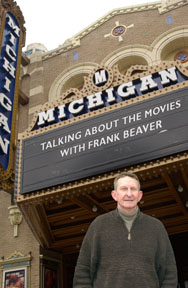
This web page is part of the Michigan Today Archive. To see this story in its original context, click here.
Documentary Technique: The Long Good Close-upThe 2004 Oscar-winning documentary The Fog of War: Eleven Lessons From the Life of Robert S. McNamara is essentially a talking-head film. That's where its power and poignancy reside. Errol Morris's film presents 11 reflective lessons about war, offered by former Secretary of Defense Robert S. McNamara. McNamara is filmed in medium close-up with the camera at a slightly tilted, oblique angle. He talks about the World Wars, his years as head of Ford Motor Company, the Cuban Missile Crisis and finally Vietnam, his most troublesome challenge as Defense chief under Presidents Kennedy and Johnson. Morris presents his audience with cut-away newsreel and autobiographical footage, but only sparingly. His primary aesthetic is in the on-going perusal of McNamara's face, with jump-cut editing driving the pace of the commentary. In a film of approximately 100 minutes, this approach, rather than becoming tiresome, leads to a sense of deep introspection on McNamara's part and of psychological awareness on the part of the viewer. One comes away with a dimensioned portrait of a man who in his twilight years seems to be living with haunting but important knowledge about his past. The use of a dominant talking-head technique as a means of exploring the relationship of an individual's life to historic realities is not new. Claude Lanzmann's nine-hour holocaust documentary Shoah (1985) is made up almost entirely of talking-head interviews with concentration camp survivors and perpetrators. Even when his interviewees seemed to have finished their thoughts, Lanzmann kept his camera running until the interviewees felt compelled to talk more, and called up further memories that deepened their stories. I first saw similar camera-interview techniques in the 1974 Oscar-winning documentary Hearts and Minds, a film by Peter Davis and Bert Schneider about the divisiveness of US involvement in Vietnam. In one instance Davis and Schneider held a lingering camera on two Vietnamese women whose families and village had been devastated by American bombs. For the viewer the effect was painful. By keeping McNamara in unrelenting close-up, The Fog of War captures its subject's hubris as well as his humanity. Film theorists have often maintained that if a filmmaker leaves a person or a thing on the screen long enough, the duration of our attention as viewers will produce varieties of meaning—some even contradictory and surprising ones—that may not have been apparent to us at first. The Fog of War, for me, affirms that conjecture.
|
|
Michigan Today News-e is a monthly electronic publication for alumni
and friends. |
| MToday NewsE | |||
|
Michigan Today
online alumni magazine
University Record
faculty & staff newspaper
MGoBlue
athletics
News Service
U-M news
Photo Services
U-M photography
University of Michigan
gateway
|
• Maps |
 Film historian and critic
Film historian and critic 